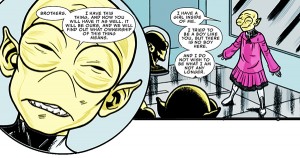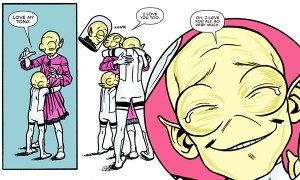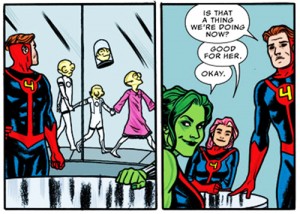 Here at PencilPanelPage we post relatively often about identity and identification (my favorite all-time post along these lines is still Quiana’s early post “Can an EC Comic Make ‘You’ Black?”). In this post I intend to continue this grand tradition. So let’s talk about my new favorite character: Tong.
Here at PencilPanelPage we post relatively often about identity and identification (my favorite all-time post along these lines is still Quiana’s early post “Can an EC Comic Make ‘You’ Black?”). In this post I intend to continue this grand tradition. So let’s talk about my new favorite character: Tong.
Tong is one of four adolescent moloids (or ‘mole-men’) who were saved by the Thing after being rejected by the other (more ‘devolved’) residents of the Forgotten City, and is taken in by the Fantastic Four (see Fantastic Four #575). Tong soon settled in with other super-powered adolescents at the special school known as the Future Foundation (the ‘FF’). Now, things get interesting when the Fantastic Four go off on a vacation in another dimension or something – they all die, but didn’t, and then I got confused!
 At any rate, the important part for our purposes (as detailed in Matt Fraction and Mike Allred’s FF volume 2) is the fact that The Future Foundation is temporarily handed over to Ant Man, who runs the school and protects the world with the assistance of She-Hulk, Medusa, and Darla Deering (in the old mechanical Thing armor). While struggling to figure out how to defeat Dr. Doom, save the world, etc., Tong discovers that she is, in fact, a girl. After donning a dress, she makes this announcement to her ‘brother’s’ (explanation for scare quotes below), and throughout the rest of the series she is identified as female.
At any rate, the important part for our purposes (as detailed in Matt Fraction and Mike Allred’s FF volume 2) is the fact that The Future Foundation is temporarily handed over to Ant Man, who runs the school and protects the world with the assistance of She-Hulk, Medusa, and Darla Deering (in the old mechanical Thing armor). While struggling to figure out how to defeat Dr. Doom, save the world, etc., Tong discovers that she is, in fact, a girl. After donning a dress, she makes this announcement to her ‘brother’s’ (explanation for scare quotes below), and throughout the rest of the series she is identified as female.
Now, I don’t want to focus on how the coming out story is told in this case (although it must be admitted that Tong’s announcement is handled in much less of a “Look, it’s a big event in comics! Hope you’re paying attention!” manner than was the introduction of a transgender character into the DC universe at roughly the same time – so kudos to Fraction and Allred for handing the story in an understated and elegant manner). What I want to think about here is the narrative potential of comics for telling this sort of story.
So here is the question: Is Tong transgender? Now, taking “transgender” on a literal reading, this would require that Tong has shifted from one distinct gender identification to another. But it is not clear that Tong really identified as male (or as having any gender or sex!) prior to her autonomous choice to self-identify as female. Of course, she and her three brothers (I’ll stop using the scare quotes, since I take it that the point of using them earlier is now becoming clear) have been identified by themselves and others as male. But it seems rather plausible that this is a sort of ‘default’ assignment due to their physical appearance. It is striking that the four young moloids rarely use singular, gendered pronouns in the comic (they usually work together, and refer to themselves communally as “we”). In the critical coming out scene it is only Tong that uses such a pronoun and, in fact, only Tong who uses the first-person pronoun “I” at all, suggesting that it is only she that in some sense has a true identity. In addition, the moloids are an engineered race, created by the High Evolutionary, and it is not clear that moloids have primary sexual characteristics of any sort (how would we understand gender identification in a culture and race that lacked biological sexes?) Heck, one of the brothers is just a disembodied head in a floating glass jar!
 I also don’t want to get into nit-picky discussions about whether or not the moloids other than Tong really do have a sex or a gender. The point I am interested in is that there doesn’t seem to be any reason (in this story at least) to assume they do at the outset. As a result, we are free to understand Tong’s choice as, in part, a decision to have a gender, rather than a decision to choose one gender over another. This, in turn, points to one of the powers of fiction – it allows us to imagine possible scenarios (such as a being without either sex or gender to actively choose to have one) that might be difficult or impossible to experience or realize in real life. In this particular case, we are confronted with a story in which gender issues play out in a way that seems distinct from how they play out in the real world (since presumably most if not all humans identify with one or another gender throughout their formative years, even if this identification is difficult and perhaps eventually abandoned for another). Considering such counterfactual scenarios could be important for our understanding of the concept of gender itself. Of course, Fraction and Allred are not the first to create stories that explore gender and sexual dynamics that are quite different from those that are usual, or even possible, within our own culture or species (Ursula Le Guin’s work comes to mind). But it is possible that comics are especially suited for this sort of exploration, because comics are (at least partially) a pictorial medium. Many of our preconceptions regarding both gender and sex are related to physical differences – that is, differences we can see. As a result, it might be the case that a pictorial medium is the ideal place to examine, explore, and subvert our preconceptions and prejudices with regard to gender and sex. It’s an interesting, and exciting, possibility.
I also don’t want to get into nit-picky discussions about whether or not the moloids other than Tong really do have a sex or a gender. The point I am interested in is that there doesn’t seem to be any reason (in this story at least) to assume they do at the outset. As a result, we are free to understand Tong’s choice as, in part, a decision to have a gender, rather than a decision to choose one gender over another. This, in turn, points to one of the powers of fiction – it allows us to imagine possible scenarios (such as a being without either sex or gender to actively choose to have one) that might be difficult or impossible to experience or realize in real life. In this particular case, we are confronted with a story in which gender issues play out in a way that seems distinct from how they play out in the real world (since presumably most if not all humans identify with one or another gender throughout their formative years, even if this identification is difficult and perhaps eventually abandoned for another). Considering such counterfactual scenarios could be important for our understanding of the concept of gender itself. Of course, Fraction and Allred are not the first to create stories that explore gender and sexual dynamics that are quite different from those that are usual, or even possible, within our own culture or species (Ursula Le Guin’s work comes to mind). But it is possible that comics are especially suited for this sort of exploration, because comics are (at least partially) a pictorial medium. Many of our preconceptions regarding both gender and sex are related to physical differences – that is, differences we can see. As a result, it might be the case that a pictorial medium is the ideal place to examine, explore, and subvert our preconceptions and prejudices with regard to gender and sex. It’s an interesting, and exciting, possibility.
So, is Tong transgender?

It is true that we rarely see the other Moloids self-identifying in terms of any gender. However, Tong addresses them in the first panel as “brothers,” and tells them “I tried to be a boy like you.” If your reading is correct, Tong becomes not just the Moloid who discovered that she is a girl, but the Moloid who discovered that she is a girl among boys.
Simon: I agree to an extent. The reference to brothers does suggest that they already self-identify as boys. But one could also see that merely as her way of emphasizing her own gender and contrasting it with theirs, while lacking a term for their own ungendered self-images (although my suggested reading would be more strongly supported if she had used “sibling” here rather than “brother”.
As I hinted at in the post, I think there are multiple ways to read this, and the question really depends, I think, on whether one could legitimately read the sequence in the manner I suggested, not whether one must.
It is also worth noting that throughout the comic Fraction seems to consistently play with our expectations with regard to the moloid siblings and their gendered role(s). For example, early issues strongly suggest they (communally) have a very strong crush on “the Jen” (a whole issue is about their sabotaging a date she has with Wyatt Wingfoot), but at the end we find out that they are really trying to get her to hook up with their savior, “the Ben”.
So I think that the comic can be read in multiple ways in this regard, and that this was probably done on purpose by Fraction. And if the reading I suggested is at all a legitimate one, even if not the only legitimate one, then that is already extremely interesting.
Roy:
I’m not at all dismissing your reading; in fact it has me rethinking this sequence in all sorts of interesting ways.
In the first panel, I’m less interested in Tong’s use of the word “brothers” than in her declaration “I tried to be a boy like you. But there is no boy here.” Tong’s “boy like you” language tells us that she identifies the other moloids as “boys,” but it tells us nothing about how they identify themselves.
This is why I think your argument is so intriguing–you raise the question of how the moloids self-identify. I’m just trying to introduce the (hopefully constructive) distinction between self-identification and intra-group identification. Tong declares that she cannot be a “boy like” her brothers, but what would it mean if she sees them as brothers while they see themselves as ungendered siblings?
Yes.
Whether by choice or by default, regardless of the fact that moloids have human genitals or not, they are read by readers and their FF peers as male – having entered a world defined in large part by a gendered binary they were put into a narrow category, as even in a world of super-beings there is little to no room in the social world for non-gendered or differently gendered beings (even the cosmic beings like Eternity (he) and Death (she) are gendered in the Marvel Universe).
These moloids are an example of the social construction of gender that is distinct from any physiological characteristics (esp. since as ostensibly prepubescent children they have not yet developed any secondary sexual characteristics to belie their gendered identity). That being the case, for Tong to assert her “girlness” is to very explicitly resist the gendered identity that has been put upon her and her brothers and that they all seem to have accepted (just as most of us accept our gender identities as they have been assigned to us), and thus she is transgendered.
Anyway, I wrote a little about this series on my blog – Fantastic: From the First, No Family is “Traditional” – from the perspective of social construction of family.
I talk about this sort of thing a little in my book (which will be out someday.) I think you’re right that comics can be used as a way of seeing how (at least some aspects of) gender is socially constructed. Drawings don’t have a gender necessarily; they’re gendered through conventions of representation and narrative. Since comics use both representation and narrative, you can put those two things at odd with one another in interesting ways.
Thanks for the comments, all. This is exactly the sort of idea I had in mind – the way that the fact that comics represent in a conventionally-laden manner can be used to explore the idea that gender is tied up with issues of culture and convention!